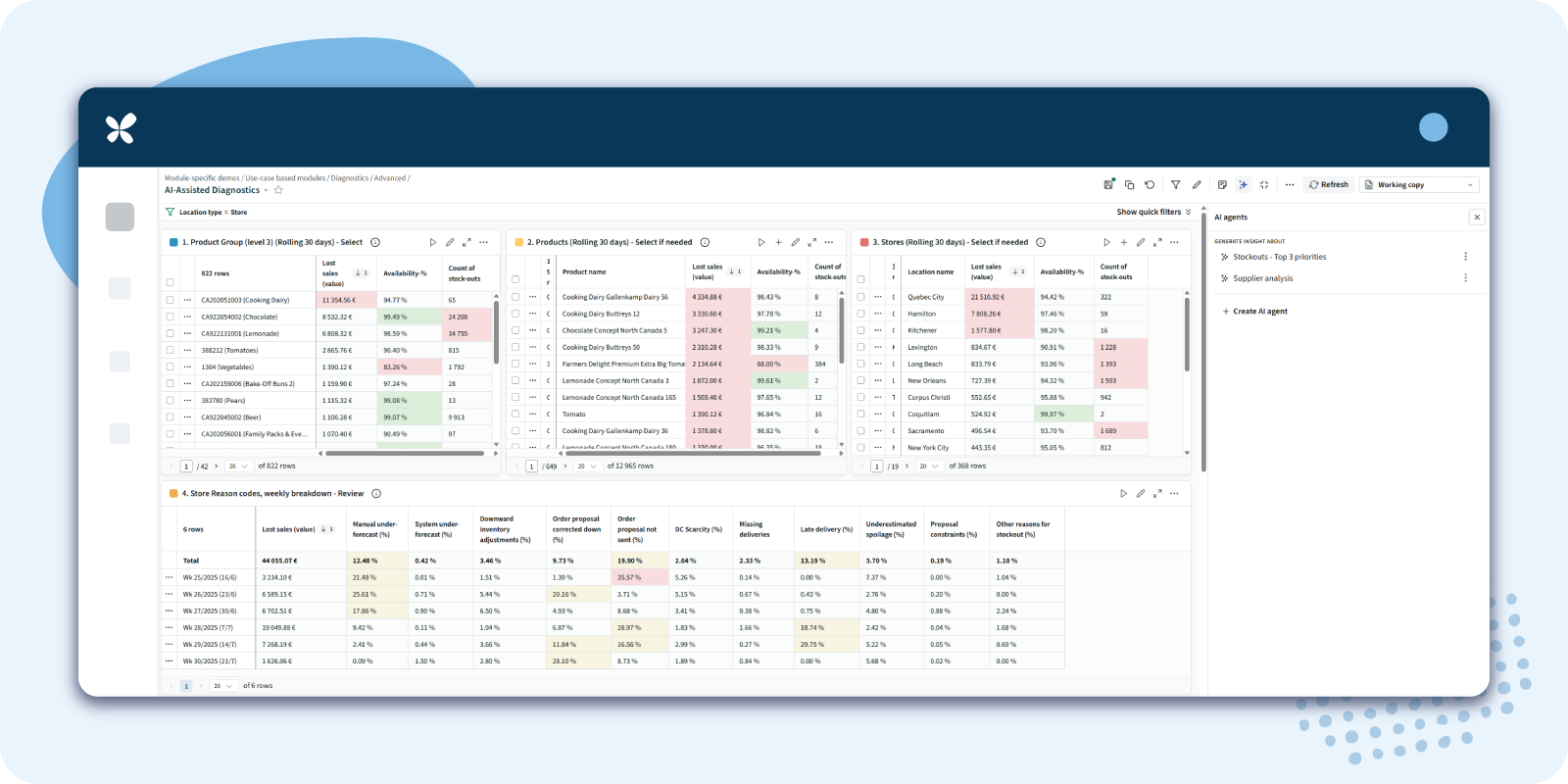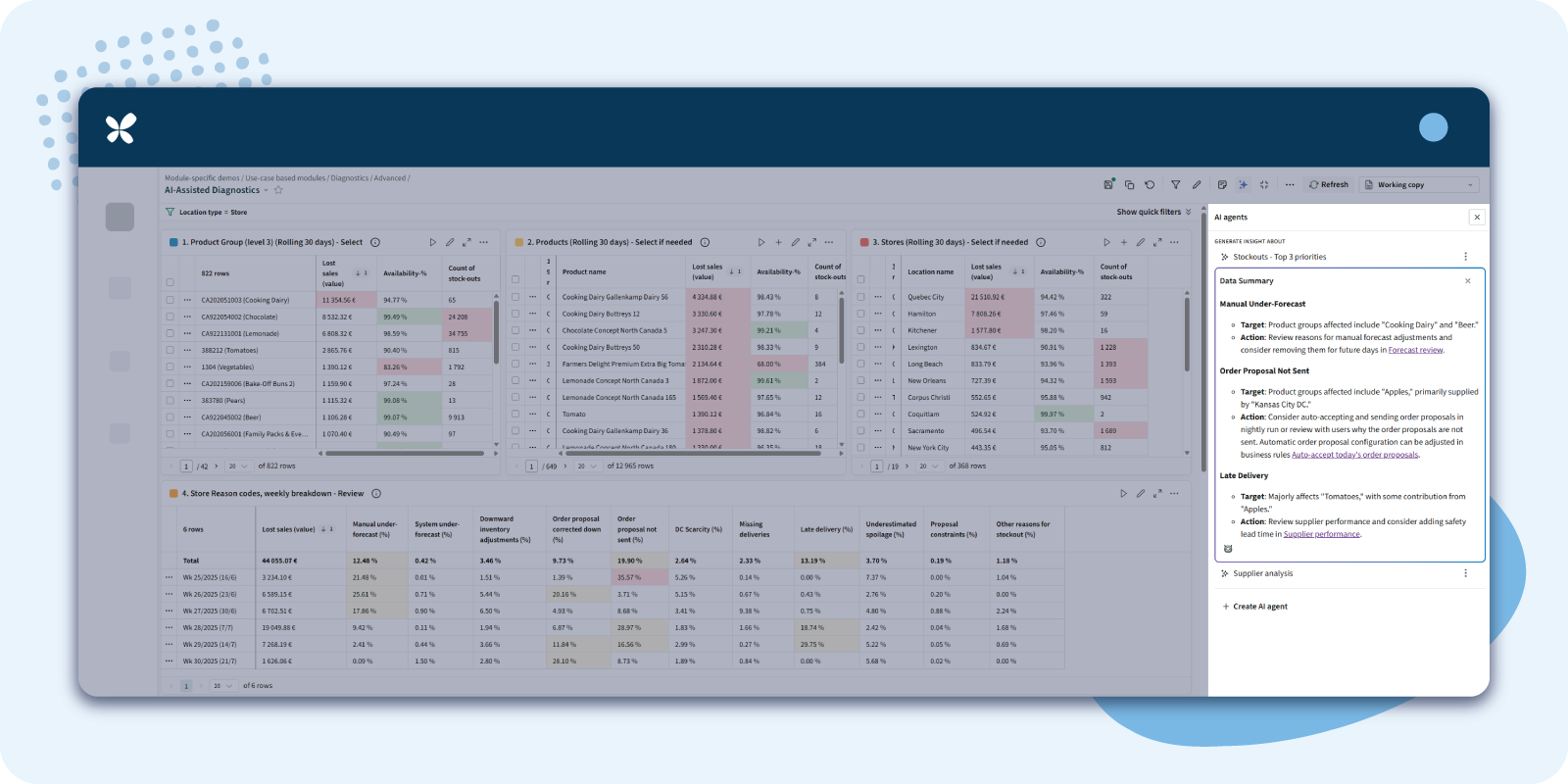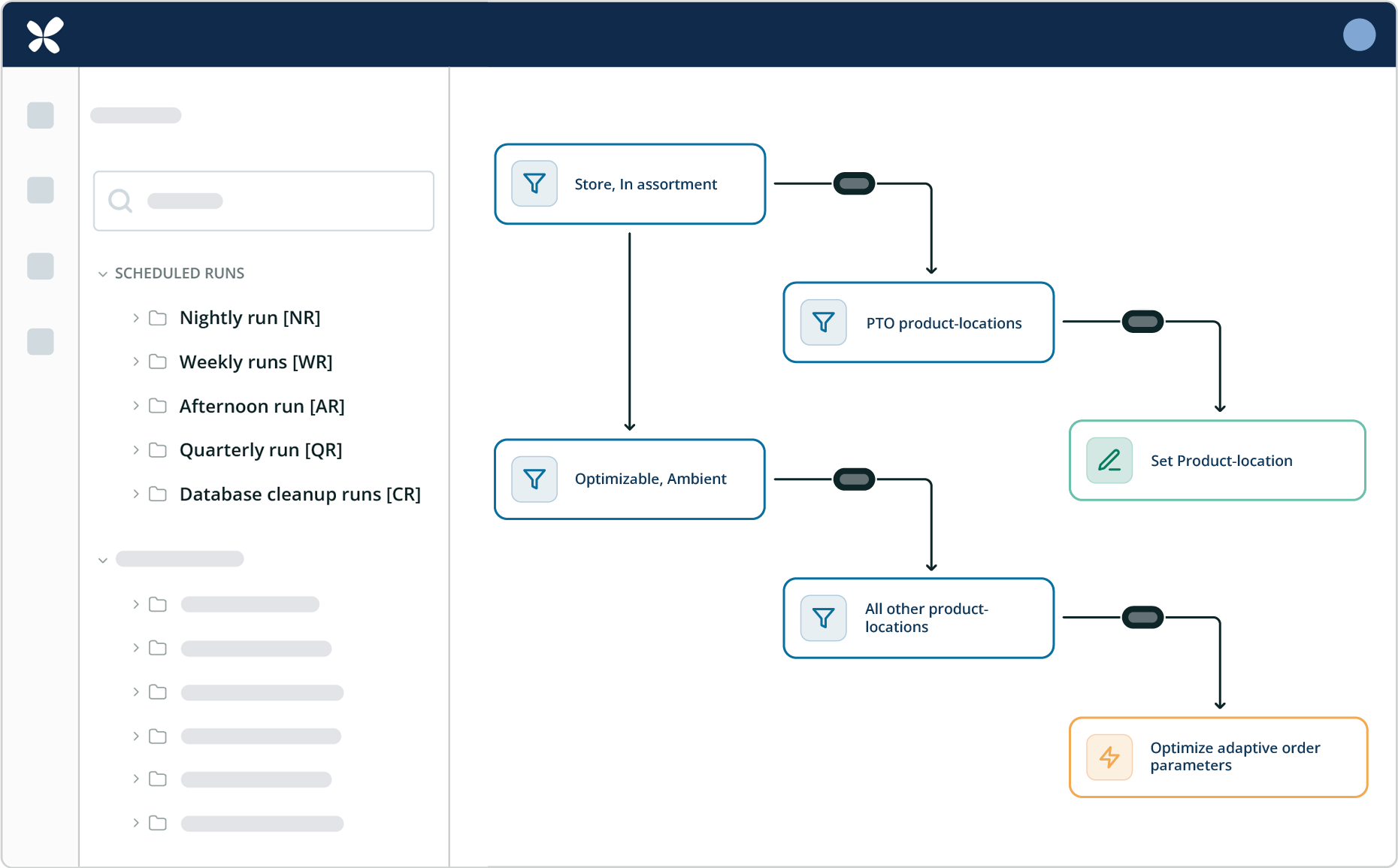How the RELEX platform turns AI agents into experts
Jul 25, 2025 • 9 min
AI agents hold tremendous potential for improving efficiency across supply chain and retail planning. These autonomous entities can recommend and take action using existing tools – including other AI technologies like machine learning, optimization, and gen AI – to speed up and improve decision-making. It sounds promising.
But the fear of pouring time and money into an AI implementation that fails is a very real one. Yes, you can create an AI agent for just about anything and tack it onto any process. But you don’t want to just turn an agent loose on your planning solutions, letting it make changes left and right without proper guidance. That’s a fast track to disaster.
The question on everyone’s mind is: “How do I ensure the agents I implement understand my industry and drive strategic decisions?”
At RELEX, we know that agents are only as good as their toolkit and their understanding of how to use it. We create effective planning agents in two steps:
- Step 1: Teach agents how to identify problems.
- Step 2: Teach agents how to assess and determine the best solutions.
Our platform equips agents with the context and tools they need to locate, understand, and resolve issues. Our advanced data management capabilities, field-proven machine learning, and AI-readable knowledgebase of best practices make it possible for agents to address industry-specific use cases and provide effective decision-making support. 100% of our customer base uses our specialized AI capabilities every day, and now agents will be able to do the same.

Let’s talk about how RELEX is developing and, in some cases, already implementing agents within the RELEX platform and discuss the emerging use cases we’re exploring with our customers.
Step 1: Ensuring agents can identify problems
It’s been an adage for a long time that your AI is only as good as your data. However, because agents can do more with your data, they need more from your data.
At RELEX, this starts with a shared, scalable, and secure data foundation that provides near-real time data from across your organization. The “shared” part is especially important. The last thing you need is to implement all these agents and have them operating in silos, making crisscrossing decisions – at scale.
A unified platform gives you a holistic and super granular view of data, down to the product-location level. It also incorporates external inputs like POS and supplier information for a clear picture of current market dynamics.
However, collecting and maintaining quality data is only the first step. To identify problems, agents need to understand what that data means. They need an interpreter. That’s where RELEX Diagnostics comes in.
How RELEX Diagnostics helps agents spot performance gaps
RELEX Diagnostics runs intense analyses on massive datasets to measure business performance through a three-step process:
- It creates a database of decisions for every product across every location and channel. It accounts for inputs and planning adjustments concerning forecasts, stock levels, product attributes, and other input variables.
- It uses this information to model future product performance at a granular level, estimating KPIs and tracking factors that could negatively impact performance.
- It compares this projection to actual outcomes, identifying underperforming KPIs. It then determines, catalogs, and weighs the root causes of those issues, such as manual overrides, supply shortages, or forecast inaccuracies.
This feedback loop is how Diagnostics measures performance and identifies the underlying causes of supply chain issues like lost sales. Plug your agents into Diagnostics and suddenly, they can understand how products at every location in your supply chain are performing. They can measure baselines and track changes, meaning they can identify which problems exist and where. They also enhance the impact of Diagnostics data by making it even easier for users to summarize, understand, and prioritize insights and recommendations.
Plus, this steady stream of insights gives you AI-enriched data. AI-enriched data is the product of the original data and the insights themselves, which become a new wealth of proprietary data that can inform decision-making.
So, you have better data, you have more data, and your agent can understand and analyze all of it.
Step 2: Ensuring agents can determine the best solution
Once agents can identify problems, how do they figure out the right action to recommend or take?
They need a supply chain and retail brain – and that’s what RELEX gives them.
First off, industry expertise is baked into the RELEX solution itself. The specialized AI that’s built into every RELEX product is called “specialized” for a reason. These aren’t generic machine learning algorithms; they’ve been honed to the specific needs of specific industries over the last two decades, and now they can be leveraged by agents. From forecasting summertime demand for DIY stores to planning stock builds ahead of the holidays, we design our algorithms to meet planning challenges across retail and manufacturing.
Agents need a supply chain and retail brain – and that’s what RELEX gives them.
We can do that so well because we’ve documented and compiled everything we’ve learned across regions, companies, and industries into a single knowledgebase. This AI-readable knowledgebase is the foundation of our gen AI assistant, Rebot.
Currently, Rebot acts as a consultant that explains industry best practices and solution capabilities. The agents we’re developing – including future iterations of Rebot – will tap into that same documentation to make smarter recommendations and take action. This knowledgebase becomes the brain for each agent.

What does this mean for our customers?
- They’re using an AI-native system that supports agents, eliminating the need to develop their own, which would be costly and time-consuming.
- They already have access to accumulated domain experience, so they won’t have to train and onboard data scientists who may not have retail and supply chain background, even if they are highly experienced.
- They can start implementing agents sooner, so they’ll achieve the benefits faster.
Read the Q&A: Agentic AI in retail and supply chain planning
AI agents and emerging use cases at RELEX
Now that we’ve outlined our platform’s technological foundation, let’s talk about how we could put it to use.
Reducing lost sales and waste with agent-generated insights
Agents are on their way to being generally available within RELEX Diagnostics, and we continue to test and pilot new use cases and capabilities.
The Diagnostics interface gives planners information about availability, stockout counts, and lost sales for specific product groups or store locations. It performs root cause analyses and displays weekly and daily breakdowns of the drivers behind each issue.

Users can access agents that generate insights and recommend corrective action. These agents will eventually be able to act autonomously, leaving major exceptions for humans to review but addressing smaller issues themselves, based on the constraints and directions given to them.
In its current iteration, Diagnostics provides preconfigured agents that help planners address issues including:
- Stockouts.
- Spoilage and waste.
- Excess inventory.
The hypothetical example below shows the dialogue box that pops up when a user asks the agent to uncover the top three issues contributing to stockouts. In this case, the agent highlights a manual forecasting override, a missing order proposal, and late deliveries as the primary causes of stockouts and recommends actions to correct each issue.

Backed by these Diagnostics agents, companies can make data-driven decisions that reduce lost sales, minimize spoilage, and optimize inventory management for wider margins and better customer experiences.
Improving responsiveness and accuracy through agent-driven configurability
RELEX is also developing configuration agents, designed to help companies respond even more quickly to sudden and drastic market disruptions. These agents will interact with the RELEX business rules engine (BRE), which our customers already use for greater flexibility and control over their planning processes.
The BRE allows users to automate tasks and decisions by setting or selecting predefined rules in an intuitive, modular interface. Companies can tailor and automate processes in house and without expensive coding changes or customization projects. The graphical interface also supports transparency by making it easy for users to follow, review, and approve what agents are doing.

If an agent can access and adjust the workflows within the business rules engine, what might the impact be?
Let’s say you’re a DIY retailer keeping an eye on a hurricane that’s about to make landfall. This isn’t a typical hurricane; it’s the storm of the century. People are depending on you for everything they need to prepare for and recover from the damage.
This is not a normal supply chain fluctuation. It will severely impact demand levels and supply availability. You realize you need to reconfigure which products go to which DCs and what supplier orders you need to increase, based on new parameters.
After running scenarios to identify the most strategic planning changes, you ask the configuration agent to adjust the appropriate workflows and triggers. This allows you to adapt and make optimal decisions quickly, providing customers with everything they need to weather the storm – all through prompts and all using the data and systems readily available through the RELEX unified platform and the business rules engine.
These capabilities give companies even faster response times, better efficiency and scalability, and ongoing ROI from their tech investments.
Building confidence in your approach to AI
AI agents are just the latest in the train of innovations that has been gaining momentum over the past couple of years. Companies realize that those who don’t implement AI capabilities risk falling behind.
At the same time, businesses are rightly skeptical of “AI solutions” making promises that seem too good to be true. The good news is that even as the technology continues to develop, business leaders can still educate themselves on the unchanged, foundational building blocks supporting this emerging technology and the innovations coming from long-time developers and industry experts like RELEX.
Plus, across the retail and manufacturing industries, businesses are at different stages of their AI journey. Even today, people are wondering where to start, and they’re – understandably – concerned about the potential risks involved in some of the newer applications, like agents and LLMs.
One of the biggest concerns centers around how to use data without jeopardizing it. Wherever you are in your supply chain planning transformation, learn how to protect your data in the age of AI.
Get straight answers to your AI and data security questions.



